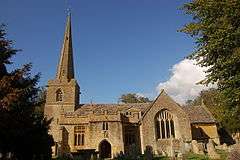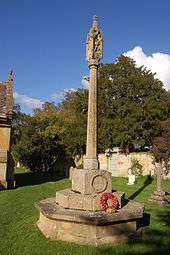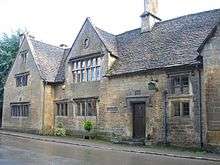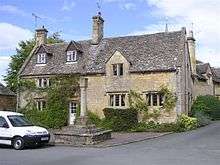Stanton, Gloucestershire
| Stanton | |
 St Michaels and All Angels parish church |
|
 Stanton |
|
| Population | 198 (2011 Census) |
|---|---|
| OS grid reference | SP0634 |
| Civil parish | Stanton |
| District | Tewkesbury Borough |
| Shire county | Gloucestershire |
| Region | South West |
| Country | England |
| Sovereign state | United Kingdom |
| Post town | Broadway |
| Postcode district | WR12 |
| Dialling code | 01386 |
| Police | Gloucestershire |
| Fire | Gloucestershire |
| Ambulance | South Western |
| EU Parliament | South West England |
| UK Parliament | Tewkesbury |
| Website | Stanton Parish Council |
|
|
Coordinates: 52°00′23″N 1°53′48″W / 52.0064°N 1.8968°W
Stanton is a village and civil parish in Tewkesbury Borough, Gloucestershire, England. The village is a spring line settlement at the foot of the Cotswold escarpment, about 2 1⁄2 miles (4 km) miles southwest of Broadway in neighbouring Worcestershire. Broadway is Stanton's postal town. The 2011 Census recorded the parish's population as 198.[1]
The parish is about 3 miles (5 km) long on a northwest – southeast axis, embracing both low-lying land northwest of the village and high Cotswold land to the southeast. On the opposite northeast – southwest axis the parish is about 1 1⁄2 miles (2.4 km) across at its widest point. Its highest point is Shenberrow Hill on the escarpment in the southeast of the parish, 994 feet (303 m) above sea level. The low-lying northwestern part of the parish is bounded mostly by two streams, which converge and then join the River Isbourne about 1⁄2 mile (800 m) outside the parish.
The village is built almost completely of Cotswold stone, a honey-coloured Jurassic limestone. It has a high street, with a pub, The Mount, at the end.[2] David Verey calls it "architecturally, the most distinguished of the smaller villages in the North Cotswolds".[3]
The Cotswold Way long-distance footpath passes through the village.
Archaeology
Shenberrow, on the hill southeast of the village, is a hill fort enclosing about 2 1⁄2 acres (1 ha). It is bivallate, meaning that its defences include two concentric ditches. It was excavated in 1935, when Iron Age pottery, iron artefacts and a bronze bracelet were found. Romano-British pottery from the second century AD was also found.[4] The fort is a Scheduled Ancient Monument.[5]
Manor
Kenulf, king of Mercia, granted the tithes and patronage of Stanton to Winchcombe's Benedictine Abbey in AD 811. Charles Wesley and John Wesley were frequent visitors to Stanton when Lionel and Robert Kirkham were rectors of St Michael's.
Sir Philip Sidney Stott, the English architect, civil engineer and surveyor, is credited with rescuing Stanton village from oblivion after he bought the estate in 1906.[3] He put his fortune and skills into restoring Stanton Court and other historic buildings in the village.
Parish church

The earliest features are three Norman columns from about 1200 which form the north arcade. The south arcade was rebuilt with Early English Gothic pointed arches, a bay longer than the previous arcade, together with a new tower of cut stone at the West end. There are hagioscopes (squints) in both transepts, an aumbry is in the north and two more in the south transept and aisle.
The font, porch and parvise are 15th-century. The original pulpit and lectern date from about 1375 and were restored in 1982. There is a second pulpit added in 1684. There are medieval encaustic tiles at the east end.
Fragments of ancient painted decoration survive. There are fragments of Medieval stained glass in the east window, the south transept and the west window, which also shows the White Rose of York. The reredos of 1915, the rood screen and the east windows of the chancel and transepts are by Sir Ninian Comper and Squire Stott. In the north transept are murals of the Annunciation and Purification, fragments of the Medieval screen.
Still visible on the south wall is evidence of stone benches for the old and infirm, dating from when most of the congregation would stand during the parts of the service that did not require kneeling. There are Medieval benches at the back of the nave: "their poppy heads ringed with the chains of shepherds' dogs".[6] There is a wooden roundel of Mauritius Wrabury
The west tower has a ring of six bells. Humphrey and James Keene of Woodstock, Oxfordshire cast the second, third, fourth and fifth bells in 1640. John I Martin of Worcester cast the tenor bell in 1659 and the treble in 1660.[7]
The church is a Grade I listed building.[8]
Historic houses

The Manor and Warne Cottage,[9] also called Warren House, is Elizabethan, with the year 1577 on a datestone.[10] Old Manor Farmhouse is also Elizabethan.[10][11]
Stanton Court
Stanton Court is a 14,644 square feet (1,360.5 m2) Jacobean manor house built for the Izod family in the early part of 17th Century. It passed to their relatives, the Wynniatt family, in the early 18th century, who then extended the house adding a wing with Georgian sitting room. The house was extensively restored for Sir Philip Stott in the 20th century.[3]
Wormington Grange
Wormington Grange was built in the 1770s.[12] Its stables were designed by Henry Hakewill and completed in 1827.[13]
Sheppey Corner
Sheppey Corner is a thatched cottage built about 1650 at the top of the High Street. It is often featured in Cotswold calendars and postcards. Like the rest of the village it is built of Cotswold stone. It was built as one large house and barn but is now divided into three cottages: the Cloisters, Sheppey Cottage, and Pixie Cottage.[14]

Railway
The Great Western Railway's main line between Stratford-upon-Avon and Cheltenham Spa Malvern Road was built through the parish between 1900 and 1905, passing about 1⁄2 mile (800 m) west of the village. The nearest station was Laverton Halt about 1 mile (1.6 km) north of Stanton. British Railways closed the line to passenger trains in 1960 and freight in 1976. The Gloucestershire Warwickshire Railway heritage railway is currently rebuilding the line.
Notable residents
- Sir Philip Sidney Stott, 1st Baronet, English architect, civil engineer, surveyor and politician.
- Hastings Ismay, 1st Baron Ismay, British general and advisor to Winston Churchill

References
- ↑ "Area: Stanton (Parish): Key Figures for 2011 Census: Key Statistics". Neighbourhood Statistics. Office for National Statistics. Retrieved 26 November 2015.
- ↑ The Mount
- 1 2 3 Verey 1970, p. 413.
- ↑ RCHME 1976, pp. 109-110.
- ↑ Historic England. "Shenberrow hill camp (1004867)". National Heritage List for England. Retrieved 26 November 2015.
- ↑ Church leaflet, circa 1990s
- ↑ Higson, Andrew (19 April 2006). "Stanton S Michael & All Angels". Dove's Guide for Church Bell Ringers. Central Council for Church Bell Ringers. Retrieved 26 November 2015.
- ↑ Historic England. "Church of St Michael and All Angels (Grade I) (1091828)". National Heritage List for England. Retrieved 26 November 2015.
- ↑ Historic England. "The Manor and Warne Cottage (Grade II*) (1091838)". National Heritage List for England. Retrieved 26 November 2015.
- 1 2 Verey 1970, p. 414.
- ↑ Historic England. "Old Manor Farmhouse (Grade II*) (1154068)". National Heritage List for England. Retrieved 26 November 2015.
- ↑ Historic England. "Wormington Grange (Grade II*) (1340084)". National Heritage List for England. Retrieved 26 November 2015.
- ↑ Historic England. "Stables, Wormington Grange (Grade II*) (1091824)". National Heritage List for England. Retrieved 26 November 2015.
- ↑ Historic England. "Little Sheppey House, No 3 and Pixie Cottage (Grade II) (1340088)". National Heritage List for England. Retrieved 26 November 2015.
- ↑ Historic England. "Village cross at Stanton (1014398)". National Heritage List for England. Retrieved 26 November 2015.
Sources
- RCHME, ed. (1976). "Stanton". Ancient and Historical Monuments in the County of Gloucester Iron Age and Romano-British Monuments in the Gloucestershire Cotswolds. London: Royal Commission on the Historical Monuments of England. pp. 109–110.
- Verey, David (1970). Gloucestershire: The Cotswolds. The Buildings of England. 1. Harmondsworth: Penguin Books. pp. 412–414. ISBN 0-14-071040-X.
External links
| Wikimedia Commons has media related to Stanton, Gloucestershire. |
- "Stanton Parish Council". Extra information about us. Gloucestershire County Council.